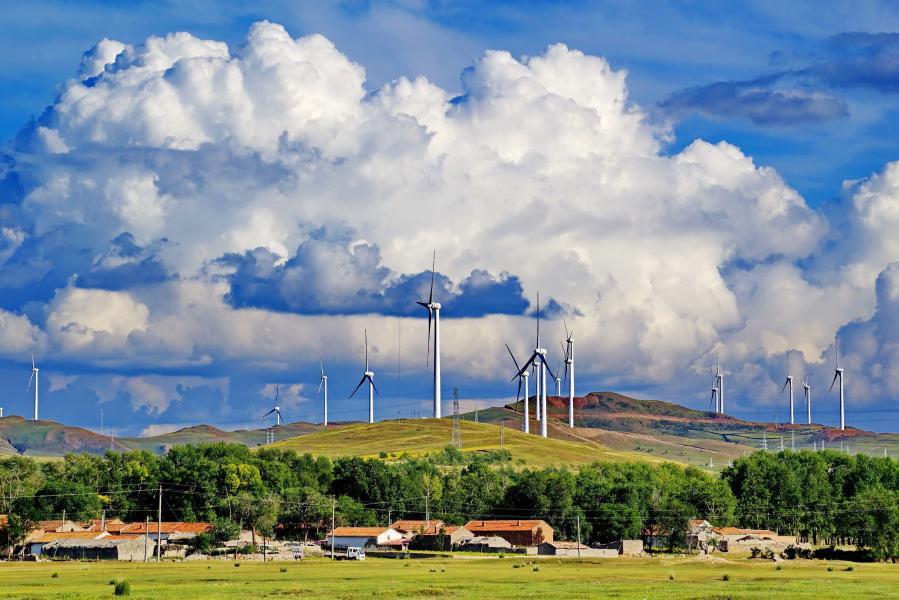China's three-year battle for blue skies brings notable achievements
 0 Comment(s)
0 Comment(s) Print
Print E-mail Xinhua, January 9, 2021
E-mail Xinhua, January 9, 2021

2020 marked the final year of China's three-year battle to bring back blue skies.
In July 2018, the country vowed to fight against air pollution in its three-year action plan, setting 2020 targets to improve major air quality indicators from the 2015 levels.
Before announcing a complete victory, China fulfilled some of the goals ahead of schedule, with its continuous air pollution control efforts yielding fruitful results.
In 2019, Chinese cities that failed to meet the national standards for average PM2.5 density saw the indicator decline by 23.1 percent from 2015, while days with good air accounted for 82 percent of the year in 337 major cities, beating the 80-percent target set in the plan, data from the Ministry of Ecology and Environment (MEE) showed.
Remarkable progress continued into 2020 as the three-year plan came to a close. In the first 11 months, the 337 cities enjoyed good-quality air for 87.9 percent of the period on average, up by 5.4 percentage points from one year earlier. The average PM2.5 density further shrank by 8.8 percent year on year to 31 micrograms per cubic meter, below the benchmark set by the World Health Organization of 35 micrograms per cubic meter.
By Dec. 27, the total number of heavily-polluted days in three key regions, namely the Beijing-Tianjin-Hebei region, the Yangtze River Delta, and the Fenhe-Weihe Plain, had been slashed by 631 from the same period in 2015.
Beijing, the Chinese capital that used to be smog-hazed during wintertime, saw no heavily-polluted skies from the beginning of autumn to Dec. 27, with good air persisting for a record 40-plus days compared with all previous autumns and winters.
Multiple efforts underway
Behind these impressive figures was a hard-fought battle during which the country tailored measures to curb air pollution.
Great efforts have gone into the green transformation of energy generation and consumption to mitigate pollution from fossil fuels. By the end of 2020, coal-fired generators with a total installed capacity of 900 million kilowatts transformed into a low-emission mode, said Xu Bijiu, an official with the MEE.
In north China's Beijing-Tianjin-Hebei region and the Fenhe-Weihe Plain, approximately 25 million households had switched from coal-burning to clean energy approaches for winter heating by the end of 2020, Xu said.
Low-pollution production is becoming prevalent in the country's heavy industries. Crude steel-producing facilities with a production capacity of 620 million tonnes are now embarking on low-emission renovations.
Meanwhile, various technological breakthroughs in air pollution control have further helped China make blue skies a regular occurrence.
Led by the MEE, scientific research groups have gathered in a program to trace the sources of air pollution, assess pollution levels, and provide pollution control solutions for the Beijing-Tianjin-Hebei region and its surroundings.
An air-pollution monitoring mechanism has gone into operation through the research program over the three years, featuring cutting-edge technologies such as satellite remote sensing and lidar monitoring. An online monitoring platform, equipped with the Internet of Things and big data, was also launched to track and locate heavy-duty diesel vehicles that may cause air pollution.
Commenting on the country's technological improvement in forecasting air pollution, Zhao Yingmin, vice minister of ecology and environment, cited Beijing as an example when noting that the accuracy of heavy pollution forecast reached 100 percent in the capital as of September 2020.
Zhao added that the accuracy of classifying air pollution levels neared 80 percent, and the city was able to provide air pollution forecasts for the public ten days in advance.
The country also led the world in promoting the use of new-energy vehicles (NEVs) amid efforts to reduce car exhaust pollution. Boasting the world's most sizable inventory of NEVs, China accounts for 55 percent of global NEV sales.
By 2035, purely electric automobiles are likely to become the mainstream in the sales of new ones, while automobiles in public transportation will be exclusively electrified, according to a development plan released by the State Council.
Looking forward to furthering measures to improve the environment next year, Minister of Ecology and Environment Huang Runqiu called for lowering carbon emissions and controlling air pollution simultaneously.
As high carbon-emitting fossil fuels, which are still widely used nationwide, produce both greenhouse gas and air pollutants, upgrading the country's energy structure and industrial structure will double the effectiveness of environmental protection, Huang said.
Accordingly, China will continue to accelerate industrial transformation and upgrades, set stricter restrictions on high energy-consuming and high-emission projects, and promote the use of non-fossil energies, Huang added.






Go to Forum >>0 Comment(s)